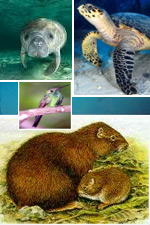The Ana Maria keys are located in the Gulf of Ana Maria, an ecosystem limited by the southern coasts of the provinces of Sancti-Spiritus, Ciego de Avila Ciego and Camaguey, the northern keys of the Jardines de la Reina archipelago and the Gulf of Guacanayabo (east).
A wildlife refuge is an area (marine, terrestrial or the combination of both) where protection and management of habitat and species turns critical to the migratory or resident wild fauna. This management category does not restrict anthropogenic activities related to the management of its natural resources as long as human intervention abides by the regulations established for such areas.
The Ana Maria keys are a natural area with no human settlements that comprises different ecosystems of high ecological and economic values. It is managed by the Enterprise for the Protection of the Flora and the Fauna of the province of Ciego de Avila and was approved as a protected area in 2001 by the Executive Committee of the Cuban Council of Ministers.
Numerous plant species grow in the area, most of them really valuable regarding their use: around 30 species of medicinal plants, over 20 may be used in the timber industry, 32 are melliferous and about 25 species of ornamental plants.
Mangroves are the most important plant formation in the keys. They are critical to keep the ecosystem in good health and are host to numerous species of birds, fish, mollusks and crustaceans of high ecological and commercial value. The entangled root system of mangroves protects these small kays from the pollutants transported by agricultural run offs and fresh water flows from the main land.
One of the main reasons to approve the Ana Maria keys as a wildlife refuge is de occurrence of a local endemic known as Cabrera’s hutia (Mesocapromysangelcabrerai), a rodent regarded as endangered due to the low number of mature individuals (less than 3 000) and the limited area of occurrence (about 300 km2). This species builds shelter in mangrove trees (roots or ground cover). The main threat to this and the other hutias species in Cuba is hunting. Cabrera’s hutias are often caught by accident in traps to catch the Desmarest's hutia, also known as the Cuban hutia. The latter is the largest of hutia and is also endemic to Cuba.
The marine habitats of the Gulf of Ana Maria include mixed seagrass beds on muddy and sandy-muddy substrates. Consequently, sea turtles like the hawksbill, the loggerhead and the green turtle species are present in the area. Like the hutias, sea turtles are also threatened mostly by fishermen that frequent the area.
Another important species found in the area is the amazing Antillean manatee, which populations have dramatically declined in Cuba, mainly because of the hunting pressure. Cuban and American scientists have been making joint efforts to recover the species and to implement management and conservation actions.
Some other important species of vertebrates are also present in this wildlife refuge: The Cuban rock iguana, an endangered species and one of the largest lizards in the Caribbean and the Cuban emerald and the Cuban pewee, two charismatic bird species.
The Ana Maria keys wildlife refuge is a small area but it is home to conspicuous invertebrate species of great ecological importance at the local, national and regional scales. For its location, it is also regarded as a potential biological corridor.



